For centuries Europeans have been drawn to the mysteries
and majesty of the Moroccan Maghreb. It has
been home to great civilisations, pilgrims, poets, artists,
writers and spiritual seekers. This is a country with
a past as colourful as its carpets. Indeed the country
has been conquered, colonised and re-conquered too many
times to mention.
The northern and western coasts provide beautiful
beaches and a sunny, sub tropical climate. The Pillars
of Hercules spectacularly brood over the Mediterranean
watching over the ferry crossing from Spain. |
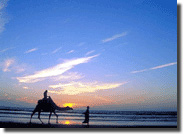 |
The western coast fringes the Atlantic,
with long lines of breakers and beaches stretching south
to the marshlands of the Mauritanian border. Much like
the European Mediterranean, the coast is dotted with farmlands
and olive trees, the link of beaches only broken by seaside
cities and towns like the capital Rabat,
and Essouira.
The three ranges of the Atlas Mountains dissect the country
from north-west to south-east. The Mid, High and Anti
Atlas descend from north to south and are all distinctive
regions in their own right. The Middle Atlas features
rolling hills covered in cedar, ash, oak and juniper forests,
and quiet cascades. Cradled between their folds are the
famous royal cities of Fes and Meknes.
The High Atlas contains Djebel Toubkal, the highest mountain
in North Africa; its peaks provide a range of tantalising
trekking possibilities.
The royal city of Marrakech sprawls
out to the scrub of the semi-desert, within sight of snow-capped
peaks. The Atlas tumble down to the southern plains and
valleys of the pre-Sahara and the oases and kasbahs of
legend. The dunes at Merzouga are among the highest in
the world, with the pre-Sahara extending to the disputed
southern borders. The arid Anti Atlas is altogether different
again and home to Tafraoute Village, with its bizarre
blue painted boulders and craggy clay-coloured contours.
Altogether this makes for a dizzyingly diverse range of
environments, all within a country the size of California.
Whatever your itinerary or interests, beauty abounds.
Morocco's charms can be likened to one of its favourite
dishes, the ubiquitous "tajine", a kind of slowly steamed
stew. Like the dish, the country's spices insinuate themselves
into the senses, producing a plethora of tastes and experiences.
One takes home myriad memories: the colourful and intoxicating
mix of fragrant spices that seduce the
traveller into a medina, a muezzin's call to prayer and
the civility of a Parisian-style cafe left over from the
French protectorate. Well after you have left, Morocco
lingers in the senses, ever-present until you can return
to its sultry charms once more. |
Morocco See & Do |
| Morocco has long
played host to travellers, and they in turn have
carried the stories and scents of the Moroccan Maghreb
to generations of Europeans eager to embrace its
mysteries for themselves. In the
1800s adventurous Europeans disguised in Arabic
attire risked death as unwelcome infidels, whilst
the traveller caravans on the hippy trail of the
'60s and '70s embraced the peaceful culture of the
Muslim faith, to the seeming bemusement of the locals.
Today your presence will be welcomed with a graciousness
and hospitality extended to every traveller who
comes to this compelling country. There are no cities
in Morocco without their medinas ,
the old towns, walled settlements now lying within
modern cities, and for most people this is where
you find the quintessential Morocco of souks and
vibrant activity against a medieval backdrop. |
Fes |
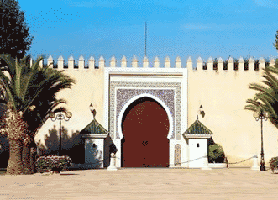 |
The city of Fes was once the spiritual
centre of Islamic North Africa and retains
that status in modern Morocco. Serenely
set among the gently rolling hill country
of the middle Atlas mountains ,
at its heart is the ancient, completely
walled city of Fes el Bali, and its World
Heritage listed medina. This sacred city
also plays host to the internationally renowned
annual Fes Festival of Sacred Music in May/June.
At any time though the thousands of winding
streets and narrow alleys create a maze
of enticing prospects. Search the souks
for bargains, or explore the Medersa Bou
Inania Islamic University's impressive 14th
century bulk and distinctly Moroccan architecture.
|
There are
plenty of other opportunities for admiring
Morocco's artisan traditions,
both those that have grown up here over the
centuries and those that are part of modern
life in the city. Take in the sunset from
the hillside Tombs of the Merinid Sultans.
As the muezzins call from the minarets, the
glistening greens and golds of the mosques'
sickle moons in the dusk capture the true
timeless nature of a city where life continues
much the same as it has for centuries. |
|
Marrakech |
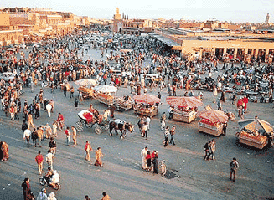 |
If a taste for the bizarre and the scents
of the bazaar are what you are seeking then
head to the red royal city of Marrakech
set within sight of the snows of the High
Atlas. The best of the city is found in
the spectacle of the famous and frenetic
Djema El Fna , "The Assembly
of the Dead" where the heads of executed
criminals and rebels were once displayed.
Today it is a small city of the living,
and filled with the characters, chaos and
colour of legend that many Moroccan travellers
crave.
Snake charmers, storytellers, medicine
men and musicians turn the square into a
cacophony of noise and a riot of colourful
experiences. Within yards of each other
you can have your palm read, your hand hennaed,
or be mesmerised by the sounds of the snake
charmer's seductive serenade. Food fare
is to be found in the evening when the assembled
lights of stalls illuminate the square.
|
| The magnificent
Koubia Mosque minaret stands
sentinel over the square, just one of the
city's many magnificent buildings. While here
you should also make sure to visit the Palais
Dar Si Said (Museum of Moroccan Arts) one
of the best collections of Moroccan style
art in the nation. Look out for the Marrakech
Festival of Arts in June/July. |
|
Volubilis |
For those with a passion
for archaeological exploration, the ubiquitous
Romans have left their mark
here as enduringly as they have across the
Mediterranean in Europe. The roman ruins at
Volubilis are set in gently rolling farmlands
and easily accessible as a day trip from either
Meknes or Fes. Built on a Carthaginian city
Volubilis functioned as an administrative
centre for this particular far-flung arm of
the Empire.
Volubilis was actually lived
in for centuries after the Romans had long
since left and you can see signs of later
settlements that made use of the existing
Roman structures.The city was eventually left
to the elements in the 17th century, but having
been lived in until this time would have counted
among the best preserved Roman remains in
the world, had it not been scavenged for building
materials. |
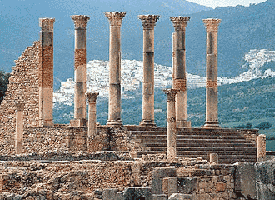
|
However,
even if parts of the city are now foundation
stones for nearby Meknes, the small section
of the city that remains is an interesting
collocation of arches, standing pillars and
mosaics . The site makes
a spectacular setting for concerts in the
summer. |
|
The Desert and Dunes of Merzouga
|
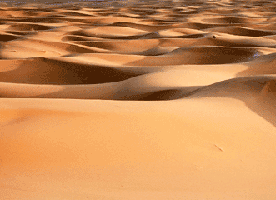 |
The south-eastern stretch
of oases run right along the road to Merzouga
and the highest dunes in Morocco's desert
regions. Here the sands of the Sahara encroach
right up to human settlements, forming dunes
that tower 100m above the sandy
floor. Deep into the south-east corner of
the country, right on the Algerian border,
the dunes' soft sands seem to float out of
the rocky, scrubby surroundings, and the magnificent
formations seem all the more miraculous for
them.
The traditional trek up the dunes at sunset
presents a panorama that is literally
breathtaking. Camel treks are also available
to explore deeper into the desert. Taking
a sunrise or sunset trip shows the dunes off
to best effect, when one side of the seif
is drenched in golden sunlight and the other
pitched in shadow. |
|
Essouira |
| The west coast seaside
town of Essouira provides an altogether different
view of the country. With its whitewashed
walls and ramparts and battlements holding
back the sea it possesses a romanticism
that has attracted and inspired
artists and filmmakers for the best part of
a century. It is a postcard pretty 18th century
city with pine trees and popular beaches.
The outer red stone walls surround the white
walls of the inner city, which in their turn
encompass the vibrant city streets coloured
in deep blue and gleaming white.
The town is inhabited by many artists and
musicians and is a popular place in the summer
months when street markets sell all manner
of Moroccan inspired artworks and souvenirs.
If you escape the crowds and wander to the
harbour you'll find yourself
surrounded by the sights and smells of Essouria's
traditional small boat fishing fleet, which
displays its own brand of artistry in uniquely
painted prows and hulls. The yearly Arts and
Music Festival in June/July highlights the
trance-like Gnawa music of Morocco and features
the fusion of many international artists from
Africa and abroad. |
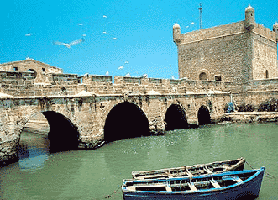 |
|
Chefchaouen |
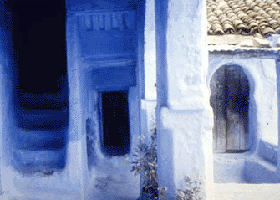 |
Chefchaouen's relaxed
Andalusian airs and spectacular
setting amongst the Rif mountains has made
it a well established destination on the backpacker
circuit, but its charms attract travellers
of all budgets. The city has attained something
of a reputation for its bohemian atmosphere
but it still has plenty of distinctly North
African elements undiluted by the travellers
who use it as a jumping off point into Africa
from Europe.
Established in the 15th century, Chefchaouen
was originally the home for refugees from
the Spanish inquisition. Isolated from much
of the rest of Morocco by geography, visitors
today find the city relatively unchanged from
its original 500-year old form. For shoppers
the colourful clothing and crafts of the Rif
Mountain people are an instant attraction.
Simple striped Berber blankets come in a variety
of shades, and the wonderfully wide brimmed
Mexican style straw hats of the women decorated
with red tassels and pom-poms on top make
striking souvenirs. |
| |
|
Tangiers |
In the first half of
the last century, Tangiers was a unique "International
City" with its own laws, rules and regulations
and a population of expats fleeing the more
restrictive, uptight mores of their own "civil"
societies. It's no surprise that Tangiers
became famed as a location where under the
table deals were struck, and anything could
be gained for the right price. It remains
a melting pot of cross-culturalism
and still has a rakish quality,
which manifests itself in plenty of hangers-on
offering to be your guide, show you a good
hotel or sell you all manner of dodgy merchandise.
Take a reliable map and be firm in your refusals
though and you can enjoy Tangiers's unique
points relatively unmolested by anyone. |
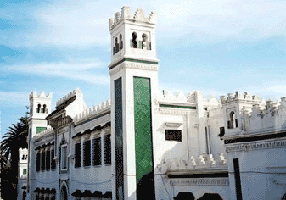 |
The city
entered literary legend as the infamous former
"Interzone" of William Burroughs' novel "The
Naked Lunch" . Burroughs wrote it
in the Hotel El Muniria during his imposed
exile from America in the '50s, and entertained
visitors Jack Kerouac, Allen Ginsberg and
Gregory Corso. American visitors might also
be especially intrigued by the American Legation
Museum, bearing testament to the fact that
Morocco was the first nation in the world
to recognise American independence.
Elegantly overlooking the straits to Spain,
Tangiers retains its reputation for freedom
and even some of its romance, and remains
a dynamic destination for dilettantes or those
determined to develop a taste for decadence
. The beaches have long been a major
draw card in summer and those nearby at Cape
Sparta and Malabata are also easily accessible
as day trips. |
|
Rabat |
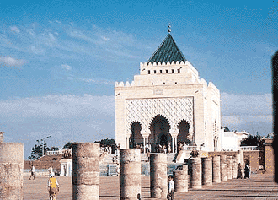
|
Rabat is the current
capital and home to the
Moroccan Government and His Excellency Mohammed
VI. It is a sophisticated seaside city with
an impressive cultural life and yearly international
arts festival. The souks both here and across
the river at Sale are excellent, and can,
like the city itself, turn up unexpected treasures.
The mausoleum of Mohammed V is an important
site of pilgrimage to pay respects to the
monarch who led Morocco to independence in
1956. The unfinished minaret that stands nearby
is the city's symbol however. Called the Tour
Hassan it was planned to be part
of Yacoub al-Mansour's iconic great mosque.
Unfortunately during construction in 1755
the site was shaken by an earthquake and building
was never resumed. Rabat can also boast several
notable museums and institutions that make
a visit here a rewarding experience. The pick
of the bunch is undoubtedly the archaeological
museum on the site of the ancient city of
Sala just outside the city. |
|
Casablanca |
| Casablanca is unlike
any other city in Morocco in its modernity
and aspirations. It is here that many upwardly
mobile Moroccans seek to assert the style
and sophistication of the modern Maghreb.
This is a truly sophisticated
North African city with a European air underpinned
by the French orientation of the city into
one of Parisian boulevards and squares. The
city's medina might not be as impressive as
those of Fes and Marrakech for example, but
is still worthy of exploration.
The magisterial Hassan II Mosque
and Mausoleum is an indication of its relative
wealth and affluence compared to other parts
of the country. The second largest mosque
in the world it is an awe-inspiring spectacle,
even if not as architecturally pleasing as
some smaller Islamic places of worship. The
massive single minaret that stands by the
main building can be seen from all over the
city and the daily call to prayers rings out
over the neighbourhood.
|
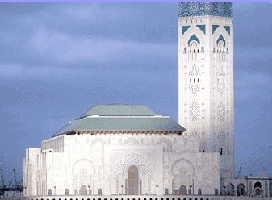 |
If visitors
are somewhat disappointed by not discovering
the laconic colonial town that Bogart shuffled
his way round in the movie then that's hardly
surprising as none of the film was actually
shot on location. In any case visitors are
more than compensated with by the experience
of a thoroughly modern North
African city, brash and self-confident. |
|
|
| |
|

